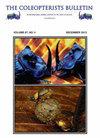书评
IF 0.8
4区 农林科学
Q3 ENTOMOLOGY
引用次数: 0
摘要
这本书包含了全面的信息,以分析和评价金属在人体毒理学。在对吸收、代谢、排泄和剂量效应关系进行简短的一般性讨论后,更详细的一章涉及生物效应和监测有毒金属的暴露。首先,从生物化学对动物系统的影响的角度讨论了生物监测的原理。然后,对九种最重要的有毒金属中的每一种的暴露指数进行了相当详细的讨论。每一种都是在解释和监测血液、尿液、头发或其他标本的意义的背景下进行处理的。第三章介绍了金属分析仪器,讨论了消解方法和具体的仪器技术。重点介绍了原子吸收法、伏安法、核活化分析法、X射线荧光法和质谱法,并简要介绍了一些其他技术,如色谱法和比色法。本章中有一个很有价值的部分涉及成本效益比以及每种主要形式的仪器的最有用的应用。第fc章至第十一章(约占全书的一半)专门讨论了对九种有毒金属的分析:铅、汞、镉、砷、铊、铬、镍、硒和碲。每一项都进行了详细讨论,包括分析技术、毒性评估和结果解释。每一章都有充分的参考,似乎包括对迄今为止文献的全面回顾。尽管对许多方法进行了讨论和回顾,但也有一些方法是详细给出的,作为例子,这不是一本方法书。然而,正如总编辑Rokus de Zeeuw博士在序言中所渴望的那样,它将成为“许多参与金属分析和解释人类毒理学研究结果的科学家的宝贵参考来源”本文章由计算机程序翻译,如有差异,请以英文原文为准。
Book Review
This book contains comprehensive information for analysis and evaluation of metals in human toxicology. After a short general discussion on absorption, metabolism, excretion, and dose-effect relationships, a more detailed chapter deals with biological effects and monitoring exposure to toxic metals. Firstly, principles of biological monitoring are discussed in the context of biochemical effects on animal systems. Then, indices for exposure are discussed in considerable detail for each of the nine most important toxic metals. Each is dealt with in the context of interpretation and the significance of monitoring in blood, urine, hair, or other specimens. The third chapter deals with instrumentation for metals analysis, discussing digestion methods and then specific instrument techniques. Atomic absorption, voltammetry, nuclear activation analysis, X-ray fluorescence, and mass spectrometry are emphasized, with short treatment of a few additional techniques such as chromatography and colorimetry. A valuable section in this chapter deals with the cost : benefit ratios and the most useful applications for each of the major forms of instrumentation. Chapters fc~ through eleven (covering about half of the book) discuss specifically analysis for the nine toxic metals: lead, mercury, cadmium, arsenic, thallium, chromium, nickel, selenium, and tellurium. Each is discussed in some detail to include analytical techniques, assessment of toxicity, and interpretation of results. Each chapter is amply referenced and appears to include a thorough review of the literature to date. Although many methods are discussed and reviewed, a few given in detail, as examples, this is not a methods book. It will serve, however, as Dr. Rokus de Zeeuw, the general editor, aspires to in his preface, as a "valuable reference source for many scientists involved with the analysis of metals and the interpretation of these findings in human toxicology."
求助全文
通过发布文献求助,成功后即可免费获取论文全文。
去求助
来源期刊

Coleopterists Bulletin
生物-昆虫学
CiteScore
1.00
自引率
14.30%
发文量
73
期刊介绍:
Founded in 1947 by Ross H. Arnett, Jr., The Coleopterists Bulletin is a refereed quarterly journal, which includes a wide variety of articles on taxonomy and ecology of beetles (Coleoptera). Both members and non-members may submit manuscripts for consideration for publication.
 求助内容:
求助内容: 应助结果提醒方式:
应助结果提醒方式:


